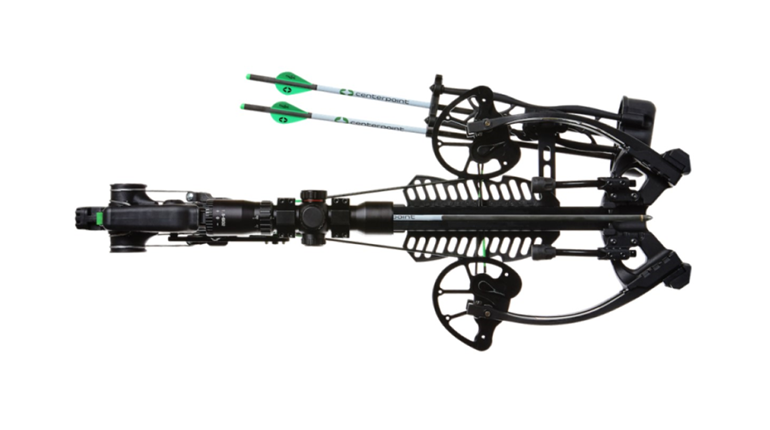All I wanted was a late-season doe. Trouble was, they’d been hunted hard and were sticking to the middle of the field, not the tree line. So I went all tactical on ’em and crawled to the weeds where they crossed the fence. At dark, 17 whitetails emerged with eyes on danger and hearts on wheat. While sitting flat on my rear to mask my profile, knees up as if I were turkey hunting, I drew smoothly, picked out a nanny and released. With a longer bow, the shot would’ve been tough.
Mathews’ new Creed XS is my favorite model ever in the archery juggernaut’s 22-year history of making some of the world’s most popular compound bows, and I’m not the guy who says that every year. What makes this one so special?
Many archers disagree with me, but I prefer a compact hunting bow. Short axle-to-axle bows allow me to sit and shoot; they’re easier to wield in treestands and groundblinds; they’re lighter and easier to carry. I use a mechanical release, so finger pinch isn’t an issue, and due to the severe string angle I can shoot while wearing my favorite “I Love Melissa Bachman” ball cap with the brim forward. I’ve never found that I shoot better with a longer bow, so I like mine small. And what fortune—the XS stands for “extra small!”
Although it’s 28 inches from axle to axle and weighs 3.8 pounds, the XS has a long 7.5-inch brace height. The longer a bow’s brace height, the more forgiving it is. While you give up a few fps, I believe a 7- to 8-inch brace height is advantageous for hunters. All modern bows are fast—and virtually everyone uses a rangefinder—so slightly flatter trajectory is not worth the accuracy given up with a short brace height. On a practice range it’s easy to shoot ultra-fast bows. While hunting, Murphy creeps, form breaks and arrows fly askew. The XS’ brace height is a big part of why I shoot it well.
Company literature touts an IBO speed rating of 321 fps. My bow, set at a lighter draw weight of 60 pounds and owning a shorter draw length of 26.5 inches, shot a 372-grain arrow 257 fps through my Easton chronograph. I’ve shot faster bows, but perhaps none quieter.
There are few smoother, either, thanks to the company’s patented Reverse Assist Roller Guard. Smooth is not an important attribute—until it helps you take a deer that’s staring at you. Some ultra-aggressive bows are impossible to draw without the cams snapping over into the valley and causing the whole bow to lurch. Not Mathews Solocam bows. While the XS’ SimPlex cam is more aggressive than past models, I’d still call it mid-range.
The XS draw features a firmer back wall than prior models as well, which enhances accuracy by ensuring each arrow is released from exactly the same point. Mush is for pillows and love letters.
A sea change for the new Mathews is its split limbs. The split limbs are parallel, and while their performance advantage is tough to measure without a laboratory, they certainly make the bow lighter.
In the past I have bemoaned the top-heavy feel of Mathews bows. Many people love it. Just goes to show feel is dependent upon perception. Much like a Glock’s two-stage trigger, a Mathews feels the way it was designed to feel and has been proven to work, yet some shooters still hate it.
I had an epiphany with the XS. I neglected to install a stabilizer—but it still shot great, and I noted its improved balance. Obviously a stabilizer won’t be going on this bow because the XS feels right to me without it; the bow’s accurate as is and it’s lighter. Besides, with a pile of vibration-dampening technology affixed by the factory—String Grubs, Monkey Tails (I cut the curlicues off so they don’t grab foliage), Harmonic Damper and Stabilizer Lite inserts, and a Dead End String Stop Lite—a stabilizer for vibration reduction is overkill. Removing the weight from the bottom of the bow stops the top from tipping forward and makes it feel less top-heavy in my hand. Try shooting the XS before installing a stabilizer just because you always have.
In past Mathews reviews I’ve begged for an alternate grip option, but the company’s been reluctant because I think it believes its walnut, palm-swell grip is the best—and maybe it is. Regardless, I give Mathews credit for now offering a slimmer, rubberized Focus Grip that I prefer for its minimalism.
Speaking of options, the Creed XS is completely customizable in terms of colors. Big whoop, you say. Yeah, I hear you, but you’re paying a grand for a new bow so why not? Check it out on the website. The XS’ riser is available in five colors including black, Lost Camo and Desert Tactical tan. I recommend Desert Tactical tan, because you never know when you’ll have to go all tactical on ’em.
Technical Specifications:
Type: single-cam compound bow
Riser: machined aluminum Geo Grid Lock
Limbs: parallel split
Cam/Let-Off: SimPlex/80%
String: Zebra Trophy
Grip: walnut palm-swell or rubberized Focus Grip
Dimensions: axle-to-axle length 28"; weight 3.8 lbs.
Brace Height: 7.5"
Draw Lengths: 26.5" to 29.5"
Draw Weights: 50, 60, 70 lbs.
IBO Speed Rating: 321 fps
Finish Options: black, Black Tactical, Lost Camo, Desert Tactical, crimson; various accessory color options
MSRP: $999


































